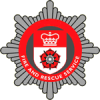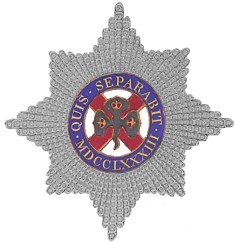Brunswick Star
Other countries use very similar stars as a background for badges and other decorations but those stars are not necessarily of Christian origin.
Some German and British military decorations share a common design known as Brunswick Cross and this is often seen with a star as a background. The star is usually eight-pointed (sometimes four or sixteen) and composed of many narrow rays. The rays are straight or wavy and the design is called the Brunswick Star.
There's an unrelated decoration for the institution of knighthood: the Most Honourable Order of the Bath. This was revived in 1725 at the request of George's chief minister, Sir Robert Walpole. There are various insignia for this Order and many include a star as a background. It is identical to the Brunswick Star but since the decoration has nothing to do with Brunswick, the design takes the name of the order and is known as the Bath Star.
Yet another elite society of warriors is the Order of the Garter, founded by King Edward III in the 14th century. Its emblem can include the same star as a background, hence another name; the Garter Star.
So why is it also called the Brunswick Star?
Well, an intriguing astronomical object located in the constellation of Eridanus is an ancient late-stage star, nearing the end of its life cycle. The German astronomer Johann Bayer published his star atlas in 1603, naming the star Alpha Eridani. In the 19th century astronomers in the German city of Brunswick (Braunschweig) catalogued and extensively studied the star. Thereafter it was commonly named Brunswick Star in honour to the city's contributions to astronomy. Several place names are named after stars, yet it's rare to have a star named after a city.

London Metropolitan police

A typical British Fire Service badge
The star, in its various names and styles, is based on the Glory Cross and is used in British heraldry to surround such things as the Royal Cypher on military and civilian badges. These include plates on the caps and helmets of almost all police forces and fire brigades in Britain and historically-related countries. The central feature of police and fire brigade badges is a local identity, such as the county's coat of arms. The star surrounds this feature to show allegiance to the crown.
When the modern police and fire services were established, it was customary for ex-military officers to be involved in selecting suitable uniforms and insignia; another reason why the star has become so ubiquitous. The familiar British police helmet, for example, was introduced by ex-military police chief officers around 1875 and based on the army's ceremonial helmet. It replaced the top hat style and other caps used by the civilian-inspired constables of Henry Fielding's Bow Street Runners and Prime Minister Sir Robert Peel's 'Bobbies' or 'Peelers'.
For the fire service of Britain and historically-related countries such as Australia, New Zealand, India and many African countries, the flames of the Brunswick Star seem more fitting than the bulging Florian Cross used in the United States.
In many other places, for example former Soviet bloc countries, Christian symbols are less common in civil and military badges. Rather than use a star or something that may be traced back to a cross, images are used which describe the nature of the job. The Israeli fire service, for example, features a helmet and two crossed axes encompassed by the Mogen Dovid. Swords, wreaths and birds, such as eagles, are also very common.
火 is the Japanese kanji character for 'fire' (ka) and one might think that the pattern of flames is the basis for the five-pointed emblem of the Japanese fire service, but that's not so. The Japanese, not having the same Christian tradition as European nations, have no cross on which to base their designs. Their fire service, police, and other quasi-military organisations use a symbol which is a relic from the former Japanese military, with a similar shape to the Brunswick Star, but based a favourite local symbol - the cherry blossom.
'Bath' comes from the purification part of the medieval knighting ceremony, where the knight would take a bath.
There are several explanations for use of the word 'Garter'. One comes from the time when the Countess of Salisbury was dancing with King Edward at Eltham Palace. Her garter fell off and to save her embarrassment, Edward picked it up and tied it to his own leg, saying "Honi soit qui mal y pense" (Shamed be the person who thinks evil of it). This is the current motto of the Order.
The Anglican Church of Southern Africa (ACSA) uses a 16-point star in its logo.
During the latter half of the 19th century, the Meiji Restoration incorporated several European ideas and designs into Japanese society. This included the Brunswick Star for the military Order of the Golden Kite (abolished in 1947) and the Order of the Rising Sun (current).
The Japan Coast Guard (JCG) ensign looks very similar to the Brunswick Star, but is in fact an eight-pointed compass, sometimes called a Compass Cross. (See also Cardinal Cross)






